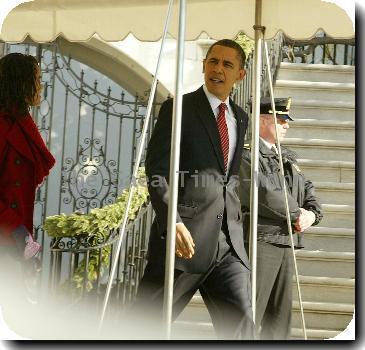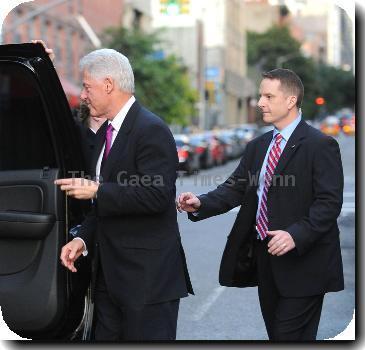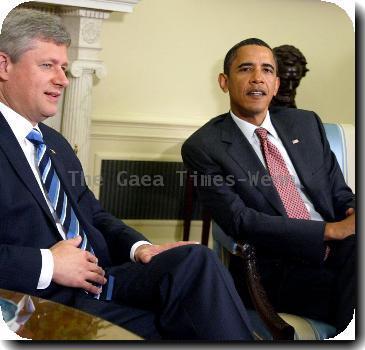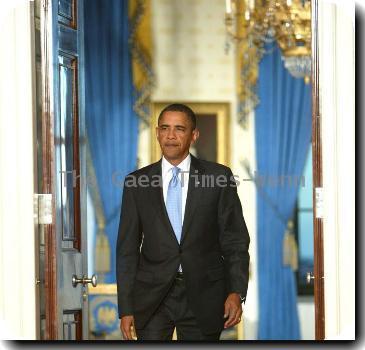Obama, US taking charge in Haiti, sending troops to keep order, aid to help rescue effort
By Jennifer Loven, APThursday, January 14, 2010
US takes charge in Haiti _ with troops, rescue aid
WASHINGTON — President Barack Obama and the U.S. moved to take charge in earthquake-ravaged Haiti on Thursday, dispatching thousands of troops along with tons of aid to try to keep order as well as rescue the suffering in a country dysfunctional in the best of times.
Tested by the first large-scale humanitarian disaster of his presidency, Obama ordered a relief effort of historic proportions despite the strains it was sure to put on both the stretched U.S. budget and military forces fighting two wars. He pledged an initial $100 million — with the likelihood of more later.
“The United States is providing a lot of the glue that is keeping people communicating and working together as we try to assert authority, reinstate the government and begin to do what governments have to do to rebuild,” Secretary of State Hillary Rodham Clinton said on Fox News Channel.
Aware of the steep political cost George W. Bush paid for an ineffective response to Hurricane Katrina, the White House has labored to show intensive engagement by Obama since immediately after the 7.0-magnitude quake late Tuesday afternoon. Details of evening Situation Room meetings, phone calls with world leaders and canceled events were being released almost hourly.
“I will not put up with any excuses for us not doing the very best in this time of tragedy,” Obama pledged at the Capitol, making his third public comments on the topic in two days.
The president announced “the first waves” of the American response were in place, with two search-and-rescue teams on the ground, Coast Guard cutters in port, the U.S. Southern Command in control of the airport and airlifts bringing in urgently needed supplies and ferrying out the injured.
But the chief emphasis out of Washington was the huge amount of U.S. help that was still on the way — some half-dozen ships and 5,500 soldiers and Marines were making their way across the Caribbean.
Seeking to pre-empt criticism, officials noted the difficulty of getting resources in as fast as they would like because of needed preparation time and then the barriers of damaged communications, roads, airport and port. Obama acknowledged it would take hours “and in many cases days” to get the full U.S. contingent to Haiti.
“None of this will seem quick enough if you have a loved one who’s trapped, if you’re sleeping on the streets, if you can’t feed your children,” Obama said. “So today, you must know that help is arriving. Much, much more help is on the way.”
The U.S. Federal Aviation Administration halted all civilian aid flights to Haiti for about eight hours, though not government ones. The Haitian government had said there was no more room on ramps for planes to unload their cargo, and some planes on the ground didn’t have enough fuel to leave. The FAA warned that flights could still expect delays of as many as three hours and possible diversions.
The role of heading the relief effort and managing the crisis quickly fell to the United States, for lack — in the short term, at least — of any other capable entity.
The government of Haitian President Rene Preval was severely disabled, with the president’s own residences damaged and the Parliament building collapsed along with other ministries and departments. In one sign of difficult conditions and dearth of official Haitian activity, White House spokesman Robert Gibbs said Obama had tried twice, unsuccessfully, to get through to Preval.
The large United Nations mission in Haiti, some 9,000-strong, was still operating, with about 3,000 peacekeepers patrolling the still-calm streets of Port-au-Prince, the country’s capital, population center and heart of earthquake damage. But the U.N.’s abilities to respond aggressively to possible problems were hobbled as well. Its headquarters building was destroyed, and dozens of its personnel, including some leaders, were dead or missing — leaving it in need of rescue help itself.
Defense Secretary Robert Gates told commanders via videoconference during the president’s Wednesday night Situation Room meeting that the military has “no higher priority right now” than the relief efforts. Those efforts include providing security, Gibbs said.
However, there was sensitivity in Washington to any impression the U.S. was taking over Haiti, a country that has seen dramatic American interventions before, not always to good effect, and is suspicious of involvement by its much larger and wealthier northern neighbor.
So Gibbs, State Department spokesman P.J. Crowley and others emphasized that the U.S. was responding only as requested by the Haitian government, with the U.S. ambassador to Haiti, Kenneth Merten, in regular contact with Preval.
A senior administration official said Obama had directed U.S. officials to “work with and through” the Haitian government “to the greatest extent possible.” The official spoke on condition of anonymity because he was not authorized to discuss private meetings.
“We have no intention of supplanting the leadership of Haiti,” said Cheryl Mills, Clinton’s chief of staff who is coordinating the efforts at the State Department.
One factor in the delicate U.S. approach is a desire to not undermine Preval and recent efforts to bring more stable governance to Haiti after decades of dictatorship and disaster have left it the Western Hemisphere’s poorest nation.
Officials said that a primary goal now — beyond immediate relief — is to restore the U.N. peacekeeping command to full strength in Haiti. For though Obama wants to effectively handle the crisis, there is no upside to what could become, in effect, protracted U.S. control of the impoverished country.
Still, officials from Obama on down promised the U.S. would be around to help long-term. Looking toward recovery and rebuilding, Obama tapped his two immediate predecessors, Bush and Bill Clinton, to oversee private fundraising — following Bush’s model of enlisting Clinton and his own father, George H.W. Bush, after the 2004 Indian Ocean tsunami. First lady Michelle Obama also was taping a public service announcement on behalf of the Red Cross.
Crowley confirmed the death of one American, career diplomat Victoria DeLong, a cultural affairs officer at the U.S. Embassy who was killed when her home collapsed. He said three other Americans were known to be missing and the embassy had made contact with nearly 1,000 U.S. citizens in Haiti, a fraction of the estimated 45,000 there.
The military was struggling Thursday to figure out how to bring in supplies and troops with a badly damaged sea port and severely congested airport. An early assessment team identified helicopters as a top priority to help ferry supplies and victims, as well as the ability to purify water and clear roads.
By next Monday, as many as 5,500 U.S. infantry soldiers and Marines were scheduled to arrive, said Defense Department spokesman Bryan Whitman. The first soldiers, from the 82nd Airborne Division, arrived Thursday, and were to be followed by 800 more soldiers on Friday. About 2,200 Marines also had been deployed.
The aircraft carrier USS Carl Vinson was expected Friday with 19 helicopters onboard, followed by other Navy ships that could also provide air lift, medical help and clean water. A large hospital ship with 12 operating rooms, known as the USNS Comfort, was to get to Haiti a week later.
Associated Press writers Anne Flaherty, Pauline Jelinek, Matthew Lee and Julie Pace contributed to this report.
Tags: Barack Obama, Bill Clinton, Caribbean, District Of Columbia, Embassies, Emergency Management, Haiti, Latin America And Caribbean, North America, Red cross, Rene preval, Search And Rescue Efforts, United States, Washington







